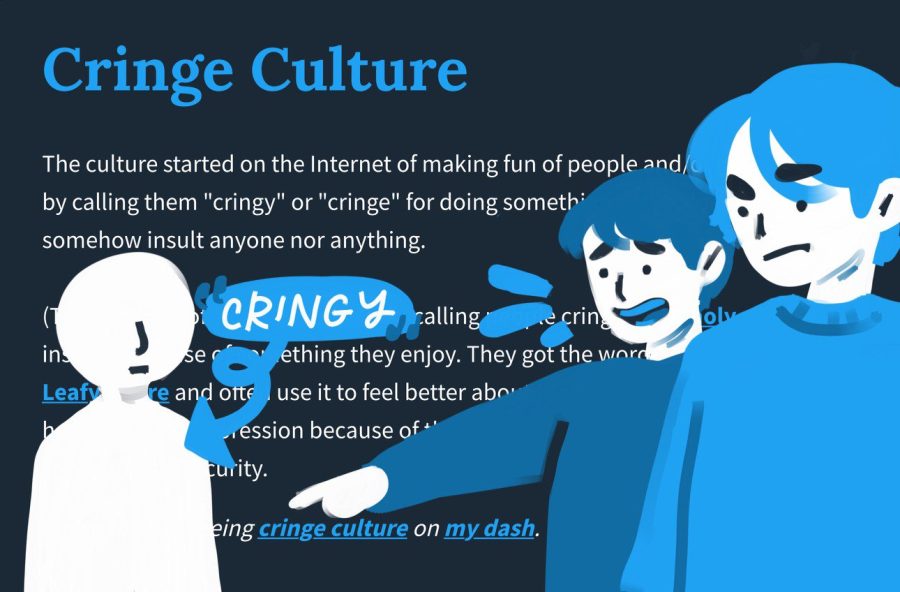A Cringeworthy Cause
The use of weaponized disgust has come to dominate online spheres and politics.
GamerGate and its subsequent culture wars are excellent case studies of how cringe culture flourishes on the internet.
January 11, 2023
A few months before I deleted TikTok, I was witness to a spontaneous wave of hatred towards a cosplayer under the username @arsenic.anarchy. The harassments were too disturbing to detail here, but suffice to say that the cosplayer eventually admitted that he was afraid to leave his house because his address had been doxxed.
His crime?
Posting a video about how Domino’s didn’t cut his pizza.
This kind of dangerously overblown reaction is, unfortunately, not a new phenomenon. Supposedly innocuous posts—most of which would normally disappear into the depths of the internet—catch the attention of thousands of people, and the posters are sent violent and often graphic threats for seemingly no reason. In the days of 4chan’s peak popularity, this was especially common due to the anonymity the website allowed. In 2010, an 11-year-old girl, Jessie Slaughter, was collectively cyberbullied by users of 4chan/b/ after posting a silly video of herself speaking in a “gangsta-rap style.”
Perhaps the largest and best-known harassment campaign was that of Anita Sarkeesian, or, as it’s more often known, GamerGate. In the autumn of 2014, thousands of men in online gaming communities began to harass, threaten, and dox feminist women in their circles, one of the most targeted of them being Sarkeesian. Even before GamerGate became the reactionary group it came to be known as, Sarkeesian was continuously harassed—so intensely, in fact, that the story made international headlines.
Much of this harassment is claimed to be because these individuals are “cringey.” “Cringe” on the internet is a loosely defined term. To those not versed in internet culture, this can seem like simple bullying, but it can become far more insidious than that. For example, one Sarkeesian lecture at a college campus had to be canceled over a mass shooting threat.
Melissa Dahl, the author of Cringeworthy: A Theory on Awkwardness, defined “cringeworthy moments” as “when we’re yanked out of our own perspective, and we can suddenly see ourselves from somebody else’s point of view,” but the type of cringe that the internet partakes in has a more sinister edge.
Natalie Wynn, also known as ContraPoints on YouTube, defines this as “contemptuous cringe.” It is a weaponized version of cringing at people that we see as ignorantly lacking in self-awareness. Wynn noted that there are patterns associated with those who are most often cringed at—those considered “deviant,” those showing a combination of passionate sincerity and amateurism, those with a perceived tendency to lack emotional composure, those with obsessive interests and unconventional hobbies, and those with a low social status.
It should be noted that many of these traits coincide with diagnosis criteria of neurodivergence, especially autism. Likewise, many of the “deviant” groups included in the list of those considered “cringeworthy” include people in the LGBTQ+ community.
However, “cringe culture,” as it has come to be known, is not just an issue of one party or side of the political spectrum victimizing another. Harassment campaigns based on “cringe” are a known weapon of the alt-right, but as the internet has developed, it has become much more bipartisan in nature.
Kaitlyn Tiffany of The Atlantic pointed out that the reaction garnered by former Speaker of the House Nancy Pelosi reading lyrics aloud from “Dear Theodosia,” a song from the musical Hamilton, was one of acute cringe.
“[O]ur sense of cringe has been heightened to truffle-pig levels of sensitivity,” Tiffany wrote. “We can sniff out the tiniest flaws in someone else’s public performance, dig them up, share them around. We’re connoisseurs of cringe. Maybe we’re even gluttons for it.”
Micheal Dombkowski, the creator of the subreddit r/Cringe, was, for his part, horrified by the violent turn of both the subreddit and the term.
“I hated that. It really bothered me,” he said. “I always saw these videos as an empathetic exercise. It was always like, Oh, I could totally see myself doing this, or it just felt like one of those nightmares where you’re at school with no pants or something. It just fills you with dread for that person.”
One of the most interesting parts of how the tide began to turn against pro-GamerGate sentiment is that it did not come from ethical journalism or fact-based studies at all. Fire was the only way to fight fire. YouTuber Harry “hbomberguy” Brewis ridiculed alt-right advocate Davis Aurini—among others of the far right—for their flimsy self images and presentation rather than the incorrect facts they drew from. Even though Brewis has advanced in his videos to a more fact-based approach, the use of cringe on the side of the left is what changed many minds.
Angela Nagle, in her book Kill All Normies: Online Culture Wars from 4chan to Tumblr to Trump to the Alt-Right, studied how the use of cringe as a weapon has changed online culture wars. In an era more focused on remaining politically conscious of others, the same weapons are being used, simply in a different war.
“The value of the currency of virtue that those who had made their social media cultural capital on was in danger of being suddenly devalued,” Nagle wrote. “As a result, I believe, a culture of purging had to take place, largely targeting those in competition for this precious currency. Thus, the attacks increasingly focused on other liberals and leftists often with seemingly pristine progressive credentials, instead of those who engaged in any actual racism, sexism or homophobia.”
Cringe, like many reactionary emotions, is not necessarily bad. Even the use of cringe as a weapon does not necessitate condemnation. But as the next generation of internet-users grow up with this culture, I, for one, am nervous to step into a new era of cringe-laden culture wars and politics.













